
European foulbrood (EFB) is a brood disease caused by the bacterium Melissococcus plutonius. EFB was first detected in Australia in the late 1970s and since then it has spread and is now found in all states and territories except for WA and NT.
Larvae of all ages are susceptible to infection and become infected after ingesting food contaminated with the bacteria. The bacterium then multiples in the mid-gut of the larvae and competes for larval food, resulting in the larvae dying of starvation. EFB is characterised by patchy brood with uncapped brood cells where the dead or dying larvae appear curled upwards, and are brown or yellow, making the larvae appear to be ‘molten’ in the cell.
The incidence of EFB is generally higher when the colony is under stress, which may be caused by hive movement, climatic conditions such as cool and wet weather conditions, or poor nutrition. Heavy infestations will affect a large percentage of the brood, weakening the colony over time, and possibly leading to the death of the colony.

Young larva with European foulbrood infected royal jelly. Rob Snyder, www.beeinformed.org
EFB is considered to be more problematic when the colony is under stress, which may be caused by hive movement, climatic conditions such as cool and wet weather conditions, or poor nutrition. Symptoms of EFB can sometimes start appearing in early spring, when the recruitment of foraging bees increases, resulting in fewer honey bees performing the nurse bee duties and feeding the developing larvae. This, in turn, places stress on the developing bees and the colony. Often when the ratio of nurse bees to larvae stabilises, the symptoms can disappear.

Close up of European foulbrood contaminated brood food. Rob Snyder, www.beeinformed.org
Despite this possibility of an increase in EFB in early spring, the signs and symptoms of EFB can be present at any time of the year. The constant threat can either be from an asymptomatic infected hive, or from the reinfection of hives by contaminated combs and equipment. The expression of the disease can change sporadically year to year, and from season to season, depending on these factors.
The EFB disease cycle is as follows:
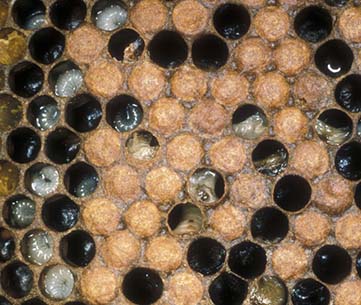
Healthy larvae are white coloured (left); unhealthy/dead larvae are a darker, yellowish colour (centre). Food and Environment Research Agency (Fera), Crown Copyright
As the disease weakens the colony it may become more susceptible to robbing bees. Any robbing bees that come into contact with the EFB bacterium then act as vectors spreading the bacteria back to the robbing bee’s colony. In severe cases of the disease, it will lead to the death of the colony. EFB is highly contagious and can remain viable for several years in honey, wax and equipment.
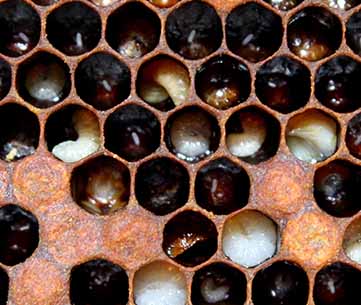
European foulbrood infected larvae appearing contorted and ‘molten’. Rob Snyder, www.beeinformed.org

European foulbrood infected larva showing the yellow/white infected larval gut. Food and Environment Research Agency (Fera), Crown Copyright
EFB causes a range of symptoms. Typical symptoms include:
Closer inspection of individual cells will show that:
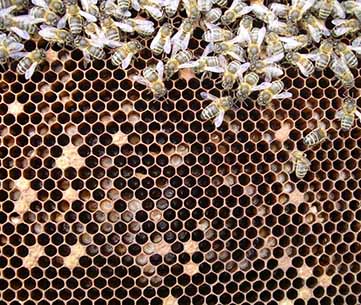
Uncapped spotty brood pattern is an indicator of EFB. Food and Environment Research Agency (Fera), Crown Copyright
Brood combs should be thoroughly examined for EFB at least twice a year, preferably in spring and in autumn, although EFB can occur in hives at other times of the year. The disease is most commonly found after the colony has been subjected to some sort of stress.
When inspecting for EFB beekeepers should remove each brood frame from the colony, remove bees from the frame and examine the brood frame for symptoms such as an irregular brood pattern, dead, discoloured larvae and/or dark coloured scales in uncapped cells. Infection can also be associated with an ammonia-like (sometimes described as sour) smell.
Individual brood cells should be carefully inspected for EFB symptoms. Pay particular attention to the colour and appearance of larvae. A typical symptom of EFB is dead larvae sitting in twisted positions in uncapped cells (although a small percentage of EFB infected larvae die after capping, which can cause EFB to be confused with American foulbrood (AFB), which typically causes larvae to die after capping). The larvae will typically change from a healthy pearly white to a yellow then brown colour while becoming a semi-liquid mass. A ropiness test can be carried out at this stage to differentiate between EFB and AFB. Over time the semi-liquid mass dries out becoming a rubbery scale that adheres loosely to the cells. AFB also develops into a scale, however, AFB scales are typically brittle and adhere strongly to the cells.

European foulbrood infected brood, showing contorted uncapped brood and EFB scale. Rob Snyder, www.beeinformed.org
Beekeeper should conduct the ropiness test on suspect cells before the scale stage of infection. This will help differentiate between EFB and AFB, which can produce similar symptoms. The test is as follows:
If the semi-fluid remains are drawn out but only form a short (usually less than 1.5cm long) thread the disease is likely to be EFB. However if a longer ropy thread is formed (usually around 3–5 cm) it indicates the hive could be infected with AFB.
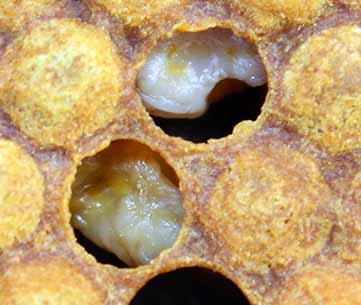
European foulbrood infected brood showing the characteristics of uncapped contorting brood. Rob Snyder, www.beeinformed.org
In advanced EFB infections, cells may also be infected with Paenibacillus alvei (a secondary infection associated with EFB). This secondary infection may also cause some extra ropiness making EFB infected brood produce a longer thread and resemble AFB infected brood. If there is a possibility that this is the case, look for other colony symptoms that may provide further clarification of whether AFB or EFB is affecting the colony. In general EFB usually kills brood prior to capping whereas AFB usually kills after capping. The texture and adhesion of the scales to the cells can also help differentiate the two diseases.
European foulbrood |
American foulbrood |
 European foulbrood ropiness. H Shimanuki |
 American foulbrood ropiness. Sam Malfroy |
|
Ropiness: Usually not ropey in its early stages, with some rope capable of being drawn out at around 1.5cm. In latter stage of infection, and possible secondary infection, the ropiness will increase. Appearance of rope: Slightly ropey, but more of a light grey semi-liquid mass, with some yellow seen due to tracheal tubes infected. Odour: Possibly sour odour. Brood pattern and stage of infection: Patchy brood with EFB cells usually containing dead, or discoloured and twisted larvae in uncapped cells. Scale: Rubbery, brown to black. |
Ropiness: Can be quite ropey, sometimes forming a fine ropey thread around 3-5cm. Appearance of rope: The ropey thread is generally a dark brown and can be quite elastic. Odour: Can be quite a sulphurous odour Brood pattern and stage of infection: Patchy, perforated brood. Infected brood usually die after cell capping. Scale: Brittle, brown to black. |
EFB is highly contagious and can remain viable for several years in honey, wax and equipment. Hives can often be infected with EFB but show no visible signs, however, sudden outbreaks of EFB can occur when the honey bee colony is under stress. For these reasons, prevention is the best method available in managing the spread of the disease amongst hives.
As with most honey bee diseases, EFB can be accidentally spread by beekeepers or through the honey bees natural activities. Beekeepers can accidentally spread the bacteria when infected combs or hive components are placed in non-infected hives. EFB can also be spread by feeding hives infected honey or pollen, or by using contaminated tools and equipment. Equipment that has been used in infected hives should be considered infected and should not be used in non-infected hives until they have been thoroughly cleaned to remove the bacteria. Hives can also become infected naturally if honey bees within the colony rob infected hives, or by honey bees drifting from infected colonies into non-infected colonies. Swarms or an absconding colony may also spread the disease between areas.
EFB is present in all continents where honey bees are kept. In Australia EFB is present in all states and territories, except for WA and NT. EFB is a reportable disease in every state and territory of Australia, except Queensland. Contact your state or territory department of agriculture if you suspect EFB and they will be able to provide advice about the best ways to manage the disease.
EFB causes symptoms that are similar to American foulbrood (AFB) and Sacbrood virus. There are a few ways to differentiate between EFB, AFB and Sacbrood virus.
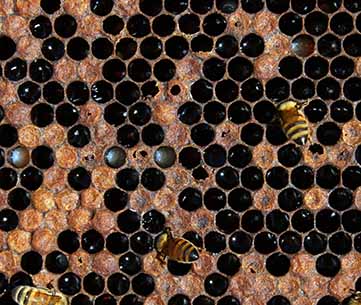
American foulbrood with perforated cappings. Rob Snyder, www.beeinformed.org
The majority (~90 per cent) of EFB infected larvae die before capping and appear coiled or twisted in their cells, which is in contrast to AFB where the majority of infected larvae die after capping. AFB infected brood commonly have very patchy brood patterns, with perforated cappings. However, when EFB infected brood die at older stages the disease can be confused with AFB.
The ropiness test (see Detection) is a simple way to differentiate between the two diseases. The test is conducted by placing a matchstick into the affected brood and slowly withdrawing the matchstick. AFB infected brood is usually drawn out in a longer ropy thread than EFB infected brood (~3–5 cm for AFB compared to up to ~1.5 cm for EFB). However, when Paenibacillus alvei (a common secondary invader in EFB) is present it may also cause some extra ropiness which can cause confusion with AFB.
The two diseases can also be differentiated by closely examining any dried scales in the cells. EFB scales are only loosely stuck to the cells and are rubbery. AFB scales tend to adhere strongly to the cells, and are brittle. Always remember that these are simple field guidelines, and the only accurate means to differentiate EFB from AFB is through laboratory diagnostics.

Nurse bees usually uncap cells exposing the Sacbrood virus affected larvae. Rob Snyder, www.beeinformed.org
Sacbrood virus can infect adults but does not produce any obvious symptoms. Infections of Sacbrood virus are most apparent when the virus infects larvae. Sacbrood virus symptoms include an uneven brood pattern with discoloured, sunken or perforated cappings scattered through the brood cells. This is generally caused from adult bees trying to remove infected brood. Although the infected larvae commonly die after capping, some dead larvae can be observed with no capping. The larvae dies with its head characteristically raised toward the top of the cell and stretched out on its back in the cell (ie banana shape). This can sometime appear similar to the ‘molten’ larvae which can appear in EFB infected cells.
EFB is often more apparent when the colony has undergone some sort of stress, such as a shortage of nectar or pollen, unfavourable climatic conditions, a poorly performing queen bee or infestation with other pests or diseases. Beekeepers should always try to keep strong colonies with a young and healthy queen bee and regularly inspect colonies for signs of EFB and other diseases. At a minimum, inspection for brood diseases such as EFB should be conducted at least twice a year, once in spring and once in autumn.
If EFB is confirmed there are a few management practices available to manage the disease. This includes:
If EFB is detected, beekeepers should replace diseased comb with new combs (with new foundation) because the diseased comb can act as a reservoir for EFB. As a precautionary measure, replace brood frames regularly (ideally every 3–4 years). Older brood frames allow diseases such as EFB to build up within the colony to damaging levels.
Since EFB is a stress related diseases, beekeepers should always try to minimise the stress placed on the honey bee colony. The maintenance of the health of the hive may require supplementing the colony’s diet with sugar syrup and fresh uncontaminated pollen when nutrition is poor. Hives should also be placed in a well-ventilated, dry area where the sun is facing the entrance of the hive to reduce conditions that favour the disease (cold and wet weather conditions).
Changes in brood-nest temperature can trigger EFB outbreaks and typically the first larvae to be affected are those around the edges of the brood where temperatures fluctuate. Therefore, beekeepers should avoid practices that can lead to loss of heat from the hive such as removing adult bees from a hive, giving a hive extra brood to rear, or adding on extra supers at the wrong time. Beekeepers should also reduce the volume of the brood chamber during the winter period to preserve brood temperatures and to allow the bees to maintain a strong winter cluster which will enable the colony to emerge in spring in a strong condition.
A key aspect of good colony management also involves the beekeeper reducing or preventing the interchange of hive materials that can spread EFB amongst hives, or to different apiaries. EFB can be accidentally spread on tools or via normal beekeeping practices, so look at implementing simple measures such as cleaning tools between hives and taking care when moving material between hives in order to reduce the spread of EFB and other pests. If you notice that some hives are infected with EFB, always clean your beekeeping gear before inspecting a new apiary.
The main way that pests and diseases, especially bacterial diseases such as EFB, are spread between hives and apiaries is through the transfer of infested materials and disease contaminated equipment. Unfortunately, it is not always possible to know if equipment is contaminated, so it is better to be cautious to prevent spreading the pest or disease from infected to healthy colonies. One way to reduce any possible transfer is to use a barrier management system.
The barrier management system is used to separate hives or apiaries into different units. This prevents the interchange of honey bees, combs, honey and hive components from one unit (hive, loads of hives or apiary) to another. The adoption of this system can also enhance traceability, biosecurity and quality assurance aspects of the beekeeping enterprise, as well as building on best practice principles.
Honey bee stocks can also differ in susceptibility to EFB, so beekeepers should replace the infected colony’s queen bee with one supplied by a reputable breeder. This variation in susceptibility is due to differences in the hygienic ability of the honey bees, which influences their ability to detect, uncap and remove the infected brood. By selecting queen bees or obtaining honey bees from hives that show this trait, and others to control and manage EFB, then the effects of this disease can be further reduced.
In some cases antibiotics can be used to treat infected hives; however there are strict regulations relating to the use of antibiotics on honey bees, which must always be followed. It should also be remembered that antibiotics will only control the bacteria infecting the bees rather than bacteria on hive components, tools or equipment, which will constantly provide a source of reinfection. While there may be at times when antibiotic treatment is a solution, this should not be seen as a one stop solution to control EFB. Always remember that antibiotic use is becoming less attractive as an option because of the possibility of contaminating the honey, and the potential for developing resistant strains of EFB over time.
Additional fact sheets from Australia and from around the world, which provide extensive information about this pest, have been listed below. To learn more, click on the links below:
European foulbrood and its control, NSW DPI
European foulbrood, Bee Base
European foulbrood, Queensland DAF
European foulbrood: a bacterial disease affecting honey bee brood, Bee Health eXtension
Australian Beekeeping Guide (2014) Agrifutures Publication No. 14/098
These videos were produced to help provide information about the pest’s life cycle and biology, identification and possible management options. Please be aware that the videos were produced overseas, and treatment recommendations or conditions experienced may differ from those in Australia.
Part 1 |
Part 2 |